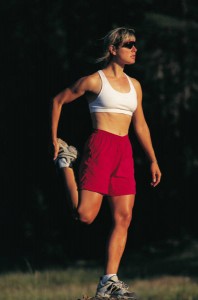 At the end of a long run, the legs are inevitably tired which is to be expected. I understand the important role that the knees play in running and that they certainly carry a lot of the body’s weight and movement. Doing core exercises and strengthening and stretching the pelvis, hips, and legs will help the knees and legs remain strong during a run. Without a strong core to keep the body in a nice straight line while running, your knees will bear the brunt of any sideways movement of the body and you’ll feel the pain later.
At the end of a long run, the legs are inevitably tired which is to be expected. I understand the important role that the knees play in running and that they certainly carry a lot of the body’s weight and movement. Doing core exercises and strengthening and stretching the pelvis, hips, and legs will help the knees and legs remain strong during a run. Without a strong core to keep the body in a nice straight line while running, your knees will bear the brunt of any sideways movement of the body and you’ll feel the pain later.
I’m pretty cognizant of my form while running but I know that I’m not nearly as consistent as I’d like to be. Like anything, establishing and maintaining proper running form takes practice. I feel as though I have a pretty straight gait and that I’m not too wobbly while running so I believe my knees are not being asked to do much more than their normal functions. However, at the end of a long run, all I want to do is stretch my knees somehow. When I squat up and down that seems to help, but I don’t know that it’s actually stretching anything. Going up and down stairs after a long run is often a chore. I have to go slow and hold the handrails. The pain doesn’t last long but it sure is uncomfortable.
After doing some researching, talking to doctor friends, reading other blogs, forums, and articles about various types of knee pain I have self-diagnosed my knee pain to be related to my Iliotibial (IT) Band, which means it is not knee pain at all. I ruled out runner’s knee as well as ligament tears and ACL injuries. There is never a good time to have any kind of pain, but I think I’m grateful that this kicked in during the last two weeks of tapering down for my first marathon rather than at the beginning of training. I identified the pain as quickly as possible and put the “treatment” a.k.a. rest and cross-training, into place immediately. The things I learned from this pain experience have already made me a smarter runner and I am now equipped with not just knowledge but also warm-ups and stretches that will improve my long-term performance and hopefully keep me injury free.
When It’s Not Your Knee
Iliotibial band syndrome, as described in an article by Marlene Cimons on Runner’s World, is one of the most common overuse injuries among runners. The IT band is the ligament that runs down the outside of the thigh from the hip to the shin and any repeated inward movement of the leg can cause ITB syndrome. She notes that causes can “include wearing worn-out shoes, running downhill or on banked surfaces, running too many track workouts in the same direction, or simply running too many miles.” Bingo-I’ve been logging lots of miles that include downhill slopes as well as cambered surfaces. I’ve also done nothing to warm-up prior to running and I have a very sporadic and usually rushed stretching routine.
I took Cimons’ advice and backed off running immediately and switched to cycling on a stationary bike so as to maintain my endurance during the two weeks before the marathon. I also consulted a local personal trainer and certified Pilates instructor for some advice on how to better stretch my legs and keep my core strong. I met with Debi Vincent, a professional trainer with 22 years of experience and owner of Active Body and Health, a small fitness studio near my house.
Dynamic & Static Stretching
Debi talked briefly about the importance of having a strong core and how engaging those muscles from the tip of your toes out through the top of your head will build overall strength and stability. I’ll cover the topic of Pilates for runners in more detail in a later post, but suffice it to say you can definitely benefit from the movements. Debi talked me through the concept of doing a dynamic work-out, a practice that David Vincent, her husband and business partner, has written about in their company newsletter. He has an article that states “many athletes start practices or workouts without stretching or with only a static stretch. Athletes should start any workout with dynamic stretching which is a specific rhythmic movement to warm up the whole body as well as provide a slight stretch.” By getting the blood flowing through the muscles and increasing the core body temperature, the muscles are more ready to move and less likely to become injured.
 I integrated four dynamic stretches that Debi suggested into my pre-work-out routine and noticed an easier transition as my heart rate increased during my cardio work-out. Find a decent stretch of space either in a hallway, room, or outside. Stand tall with good posture, engage your core, and do one length of walking knee hugs, the next of walking quad stretches, then forward kicks extending your opposite arm to tap the raised foot, and outward leg rotations to warm up the hips. Alternate stretches for 5-10 minutes to get all the muscles moving.
I integrated four dynamic stretches that Debi suggested into my pre-work-out routine and noticed an easier transition as my heart rate increased during my cardio work-out. Find a decent stretch of space either in a hallway, room, or outside. Stand tall with good posture, engage your core, and do one length of walking knee hugs, the next of walking quad stretches, then forward kicks extending your opposite arm to tap the raised foot, and outward leg rotations to warm up the hips. Alternate stretches for 5-10 minutes to get all the muscles moving.
David points out that static stretching tells the body it’s time to slow down and should be done at the end of a workout. I was familiar with a number of standing stretches that can be done to stretch and strengthen the IT Band and Debi gave me some additional floor stretches to add to the routine.
Lying down, engage your core muscles keeping your lower back on the floor. Bend both knees on floor and raise one to 90-degree angle, extend leg out, and bring back in. Repeat 10 times, switch legs. Next, raise one leg straight up and keeping straight slowly raise and lower 10 times, switch legs, and repeat. To increase resistance and stability for these two, Debi suggested using a stretch band or Yoga band pulled around foot and held taut in hands. Another good stretch: extend one leg straight up, put arms out to side on the floor to anchor your core, and slowly bring leg in across your body without raising your hips, stretching the inner thigh, repeat 10 times and switch legs. In doing each of these stretches, it became instantly obvious to me that I have not been stretching enough of the right muscles nor have I focused on holding the stretch long enough.
While it’s frustrating to not be running even short distances in the final taper before my first marathon, I am grateful to have the proper combination of rest and stretches to get my IT Band back to where it should be-pain free! And I’m sure glad the problem is not my knee!

Pingback: Thresholds: Heart Rate Help | Health and Running
I ran a half marathon 2 weeks ago. Alot of pain running along the sides of my knees. I have iced and rested and stretched. No pain until I ran again up and down hills 3 miles today. Pain is back. When I walk after no pain. What can I do in 1 week running a 5k.